Coronavirus (COVID-19): state of the epidemic - 23 December 2021
This report brings together the different sources of evidence and data about the Covid epidemic to summarise the current situation, why we are at that place, and what is likely to happen next.
State of the Epidemic in Scotland – 23 December 2021
Background
This report summarises the current situation of the Covid-19 epidemic in Scotland. It brings together the different sources of evidence and data about the epidemic in Scotland at this point in time, why we are at that place, and what is likely to happen next. This summarises the data up to and including 22 December 2021 on Covid-19 in Scotland. This updates the previous publication published on 17 December[1]. The information in this document helps the Scottish Government, the health service and the wider public sector respond to the epidemic and put in place what is needed to keep us safe and treat people who have the virus.
This edition of the State of the Epidemic summarises current data on Covid-19 at a national and local level, and how Scotland currently compares to the rest of the UK. It looks at the vaccination program in Scotland and its impact. Information is provided about variants of concern and what impact these may have. Bringing this information together in one place gives the opportunity to better understand the current state of the epidemic in Scotland.
Please note this report has been published earlier than usual this week due to the Christmas Holiday. Next publication will follow on 7 January 2022. Due to earlier publication, Covid-19 case rates in children and young adults have not been updated. The update will resume with the next publication.
Public Health Scotland (PHS) are aware of larger volumes of tests being processed by laboratories. This appears to have impacted turnaround times resulting in delays between specimens being taken and results being received and reported. PHS continue to monitor the situation.
Additionally, PHS reported that positive case numbers were lower than expected for cases reported on 22 December 2021. At the time of writing this issue is still being investigated. As a result, in this report, testing data and cases by reporting day cover until 21 December 2021 and cases by specimen day cover until 18 December 2021.
Key Points
- The latest R value for Scotland, as of 7 December (using data to 20 December), was between 1.0 and 1.3, with a growth rate of between 0% and 4%. The lower and upper limits have increased since last week for both R value and growth rate.
- Latest modelled estimates suggest that, as at 7 December, the incidence of new daily infections in Scotland was between 124 and 159 new infections per 100,000. These figures are based on data to 20 December 2021.
- An average of 5,608 cases were reported per day in the 7 days to 21 December. This is a 50% increase from the daily average of 3,750 recorded on 14 December. Please note that due to technical issues, cases reported on 22 December 2021 are excluded from this analysis.
- In the last week, 7 day case rates in Scotland have consistently increased. There were 705 weekly cases per 100,000 population in the week to 18 December, which is a 54% increase from 458 weekly cases per 100,000 on 11 December. This is lower than the most recent peak (825 weekly cases per 100,000 on 6 September) but higher than the peak in July (425 weekly cases per 100,000 recorded on 3 July). Please note that due to technical issues cases by specimen date only cover until 18 December 2021.
- As of 18 December, the highest case rates (by specimen date) were observed amongst those aged 20-39, followed by under 20, 40-59, 60-79 and 80+. In the week to 18 December, case rates have increased in all age groups.
- 62.9% of all PCR tests from Pillar 2 Lighthouse Labs had the S-gene target failure, as reported on 21 December. S-gene target failure is used as a proxy for Omicron cases. Please note that due to technical issues, cases reported on 22 December 2021 are excluded from this analysis.
- A total of 1,478 confirmed cases of Omicron variant (B.1.1.529), as determined through whole genome sequencing, have been reported up to 21 December. Please note that due to technical issues, cases reported on 22 December 2021 are excluded from this analysis.
- In the week to 22 December Covid-19 hospital occupancy and Covid-19 ICU occupancy (short and long stay) decreased by 1% and 4% overall from this time last week.
- There were 68 deaths registered where Covid-19 was mentioned on the death certificate in the week to 19 December 2021. This is a decrease of 17 (-20%) in the number of deaths from the previous week.
- Nationwide, wastewater Covid-19 RNA levels have shown an accelerated increase in the past week. The week ending 20 December saw levels of around 129 million gene copies per person per day (Mgc/p/d), up from around 55 Mgc/p/d in the previous week, an increase of 135%. This matches the recent rise in cases caused by the rapid spread of the Omicron variant.
- West Lothian currently has the highest weekly case rate in Scotland reporting 1,045 weekly cases per 100,000 in the week to 18 December. Shetland has the lowest case rate in Scotland, reporting 310 weekly cases per 100,000 population.
- As determined through the latest weekly ONS survey, the percentage of people testing positive for Covid-19 in the private residential population in Scotland increased in the most recent week (10 to 16 December 2021).
- Due to uncertainty surrounding the Omicron variant and its increasing prevalence across the UK, SPI-M has been unable to produce consensus medium-term projections for hospital admissions and ICU occupancy this week.
Method
This report brings together a wide range of publically available figures from a range of data sources. These include publications by Scottish Government, Public Heath Scotland, National Records of Scotland and Office for National Statistics along with scientific publications and SAGE and UKHSA summaries where appropriate to summarise the state of the epidemic in Scotland in a given week. We also provide information on public attitudes to the virus from weekly YouGov polling surveys.
The National Picture
Estimated Infection Levels
The latest R value for Scotland as of 7 December was between 1.0 and 1.3 (Figure 1), with a growth rate of between 0% and 4%. R is an indicator that lags by two to three weeks and therefore should not be expected to fully reflect the increased prevalence of Omicron in the last week. These figures are also based on data to 20 December 2021[2]. The lower and upper limits have increased since last week for both R value and growth rate.
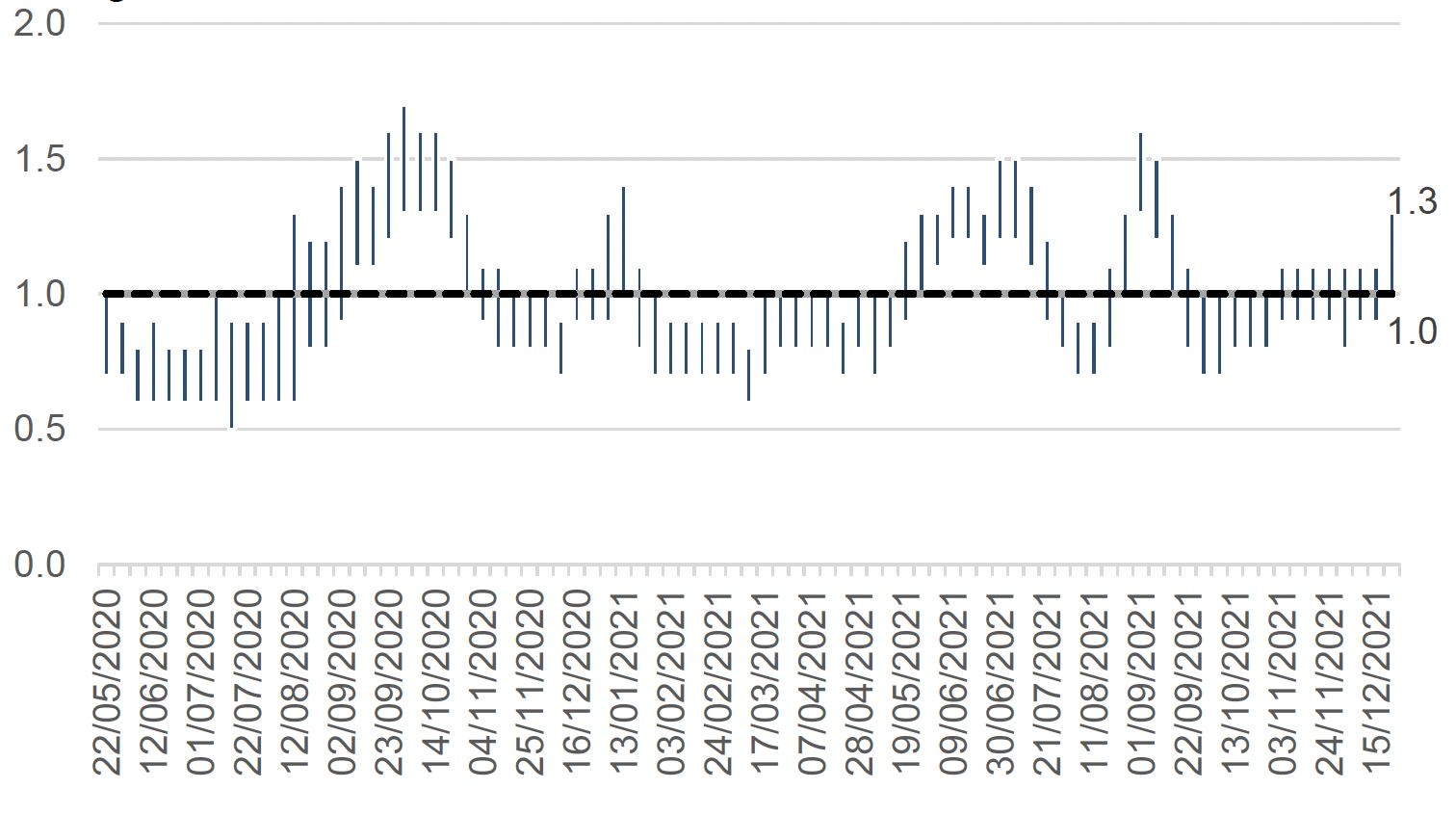
Not everyone who has the virus will be tested, as many people do not realise they have Covid-19, or they have mild symptoms and do not come forward. Latest modelled estimates suggest that, as at 7 December, based on data to 20 December, the incidence of new daily infections in Scotland was between 124 and 159 new infections per 100,000[3]. This equates to between 6,800 and 8,700 people becoming infected each day in Scotland.
Covid-19 Cases in Scotland
An average of 5,608 cases were reported per day in the 7 days to 21 December. This is a 50% increase from the daily average of 3,750 recorded on 14 December[4]. This includes 1,478 cases of confirmed Omicron variant (B.1.1.529) which had been reported up to 21 December[5]. Please note that due to a technical issue cases reported on 22 December 2021 are excluded from this analysis.
In the last week, 7 day case rates (by specimen date) have increased consistently in Scotland. There were 705 weekly cases per 100,000 population in the week to 18 December, which is a 54% increase from 458 weekly cases per 100,000 on 11 December[6]. This is lower than the most recent peak of 825 weekly cases per 100,000 on 6 September but higher than the previous peak of 425 weekly cases recorded on 3 July (Figure 2). Please note that due to a technical issue cases by specimen date only cover until 18 December 2021.
In the week to 17 December 2021, there were 600 cases (PCR testing only) per 100,000 among unvaccinated individuals, compared to 202 cases per 100,000 for those that had been vaccinated with three doses[7].
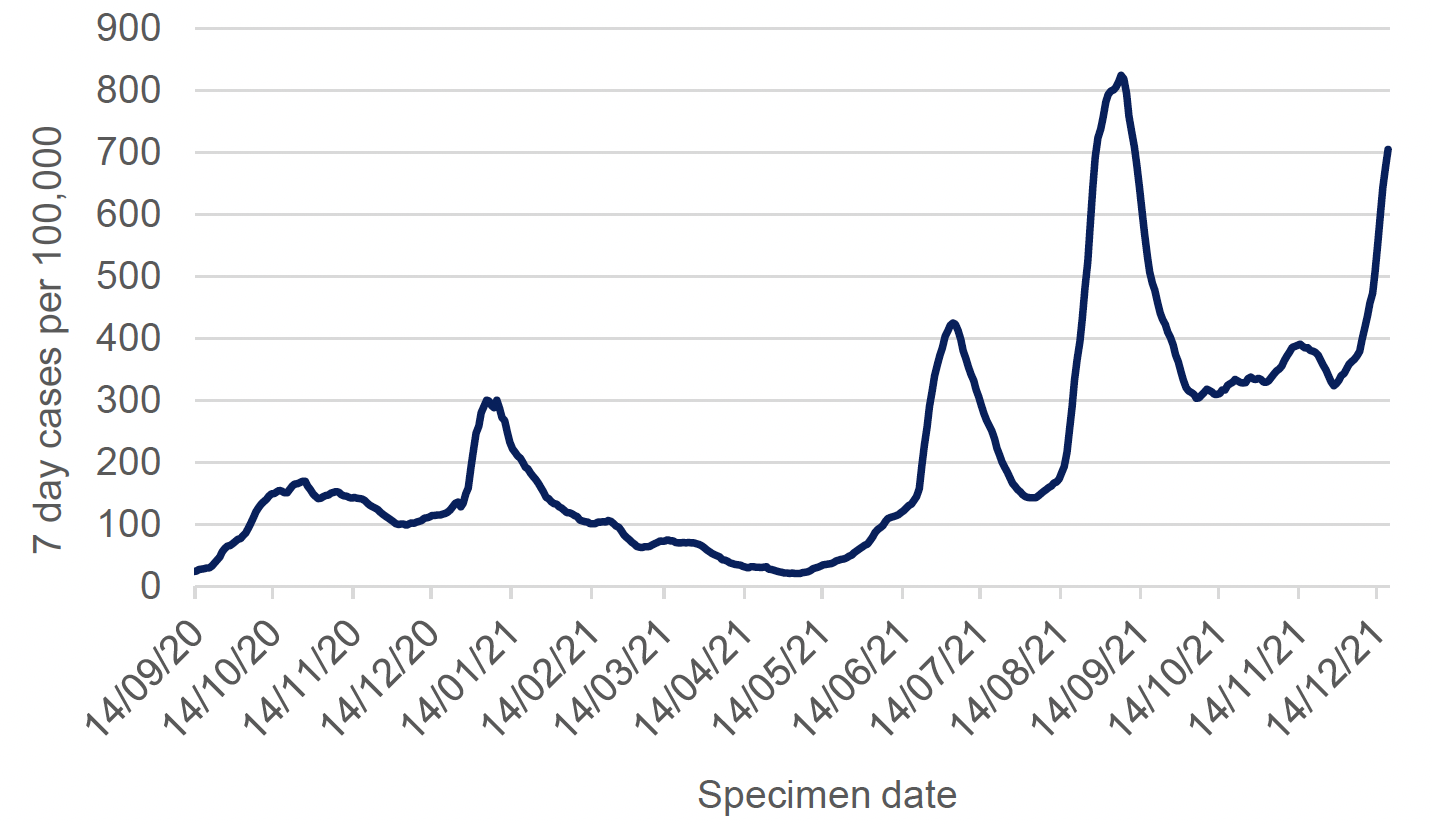
As of 18 December, the highest case rates (by specimen date) were observed amongst those aged 20-39, followed by under 20, 40-59, 60-79 and 80+. In the week to 18 December, case rates increased in all age groups (Figure 3). Those aged 20-39 saw largest increase in case rates which doubled over the latest week. Please note that due to a technical issue cases by specimen date only cover until 18 December 2021.
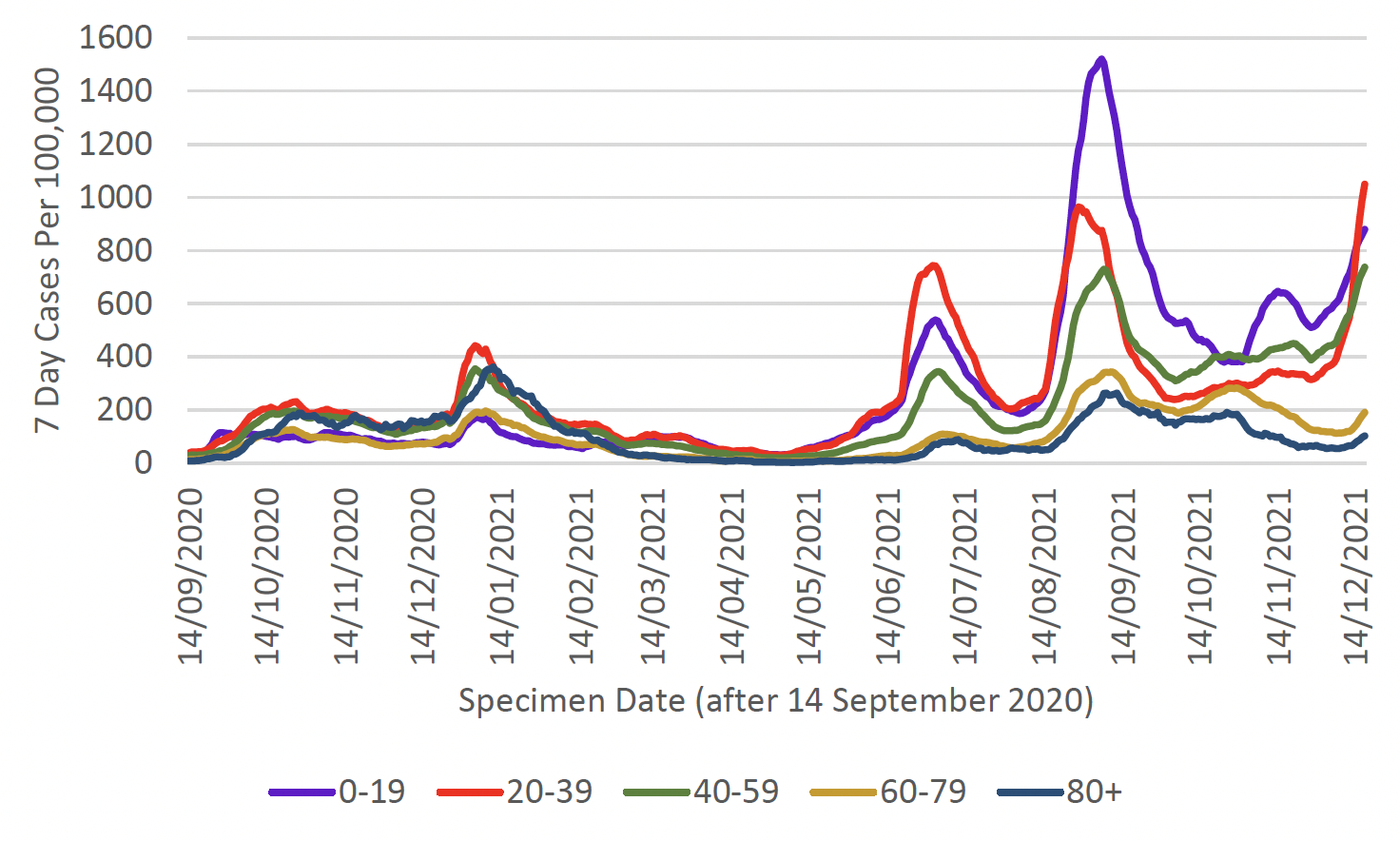
Please note that the latest data on case rates among children and young adults is not available in the State of the Epidemic report this week due to the earlier publication date. These figures will however be published as part of Public Health Scotland Covid-19 Education Surveillance Report on Friday 24 December 2021 and can be accessed through the following link: https://scotland.shinyapps.io/phs-covid19-education/_w_852fb58e/
Omicron variant
Please note that due to a technical issue, positive cases by reporting day cover until 21 December 2021 and cases by specimen day cover until 18 December 2021 in the below section.
On 23 November 2021, a small number of cases of a new variant were reported by South Africa to the international genomic database, GISAID. This variant was designated B.1.1.529 on 24 November 2021 and has over 30 mutations within the Spike protein. On 26 November, WHO designated B.1.1.529 as a SARS-CoV-2 Variant of Concern known as Omicron.
The latest Omicron risk assessment carried out by the UK Health Security Agency (UKHSA), established with high confidence from analysis of UK data that Omicron is showing increased household transmission risk, increased secondary attack rates and substantially increased growth rates compared to Delta[9].
Like the Alpha variant, which once was dominant in the UK, Omicron has a mutation that leads to S gene target failure in a widely-used PCR testing platform available at UK Pillar 2 Lighthouse Laboratories. S-gene target failure (combined with positive detection of the other two target genes (ORF1AB and N)) has therefore been identified as a reasonable proxy for Omicron variant (B.1.1.529) in the UK.
Scientific evidence indicates that Omicron has some ability to evade natural immunity from prior infection. Multiple laboratory trials report the potential for reduced vaccine efficacy with Omicron compared to previous variants, analysis of real world vaccine effectiveness data in the UK and South Africa highlights reduced protection against infection and an increase in the risk of reinfection with Omicron has also been documented. However, the administration of a third booster dose should increase vaccine effectiveness against symptomatic infection to over 70%[10]. A recent study analysing all PCR positive cases in England (test specimen dates 1 to 14 December inclusive), reported a reduction in the risk of hospitalisation for Omicron relative to Delta[11]. However they caution that these reductions must be considered against the increased risk of infection with Omicron and the severity profile may be different in older age groups.
Omicron is spreading at a rate that threatens a rapid and large surge of Covid-19 cases. Even if the resulting illness is relatively mild the number of cases could potentially cause great disruption to other services, in the economy and businesses, and in wider society, as more people would be absent from work due to illness and asked to isolate if they test positive, or as contacts of someone who has tested positive. It also means that the rapid rise in Omicron infections could put significant additional pressure on hospitals and other health and care services, close to the point in the winter when they are already likely to be at peak pressure.
Omicron is now the dominant strain of the virus within Scotland with widespread community transmission. As of 21 December, S-gene target failure (SGTF) cases were at 62.9% of all PCR tests from Pillar 2 Lighthouse Labs, and have risen exponentially (Figure 4)[12].
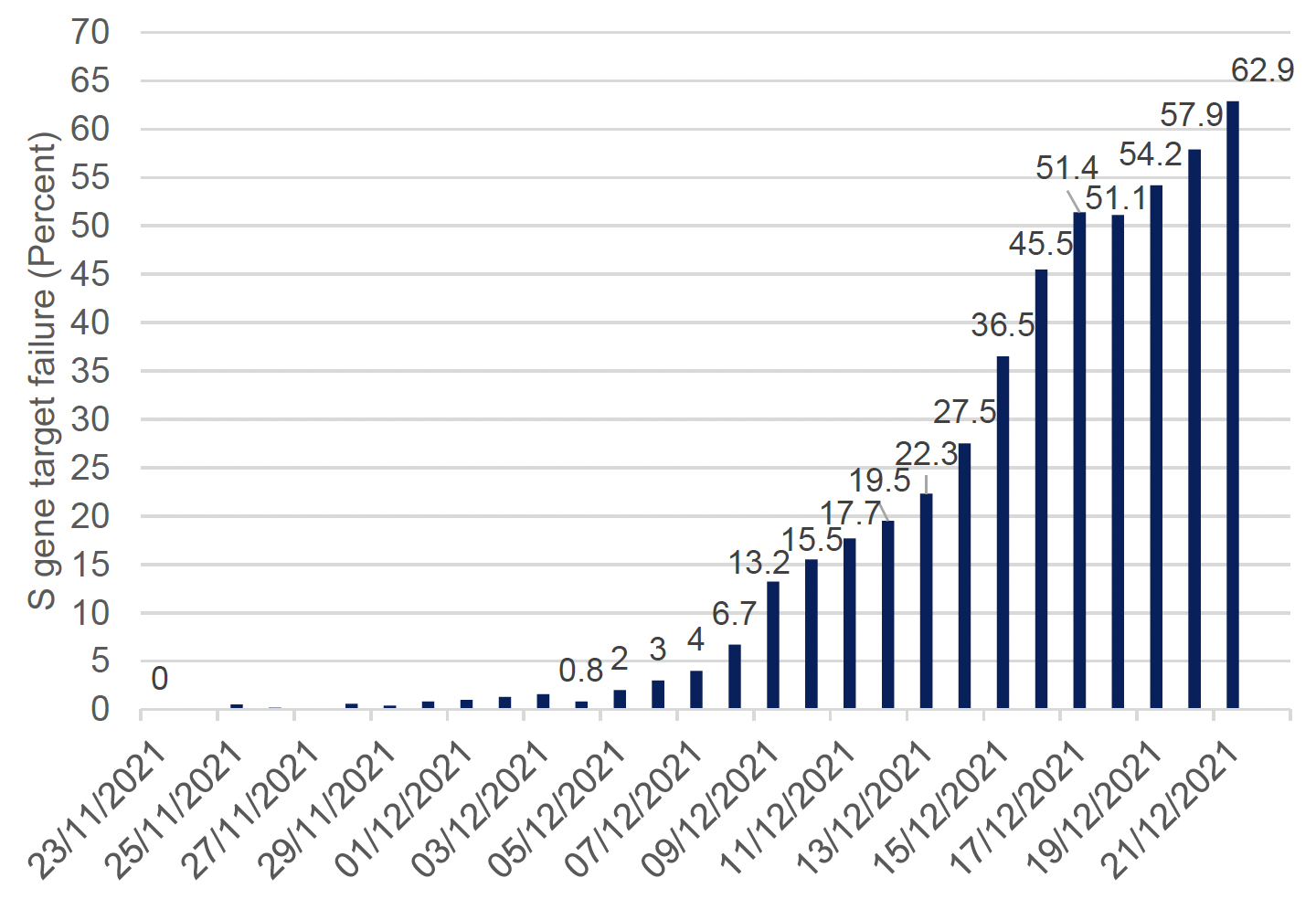
An analysis published by Public Health Scotland (PHS) on 22 December 2021[14], with data up to 19 December, shows a number of confirmed Omicron cases, as well as those which are highly probable and possible; a total of 21,975 Omicron cases were reported, of which 1,111 (5.1%) were confirmed, 20,777 (94.5%) were highly probable and 87 (0.4%) were possible (Figure 5)[15] [16].
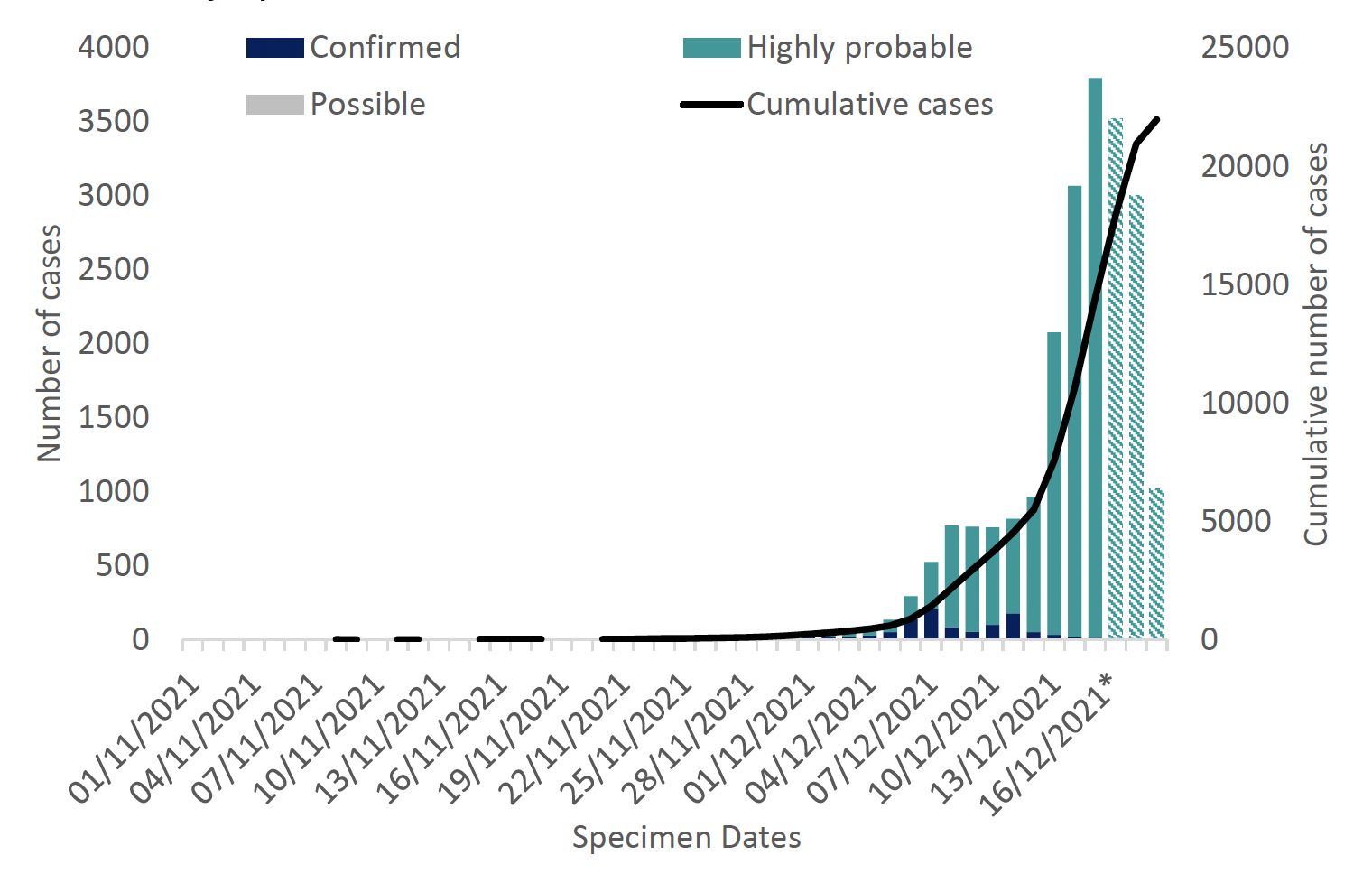
Public Health Scotland reports sustained community transmission of the Omicron variant (based on data through 19 December 2012)[19] and cases are widely spread across Scotland's Health Boards; the highest numbers of confirmed, highly probable and possible cases under investigation have been detected in the Greater Glasgow and Clyde (a total of 6,532 cases), Lothian (total of 5,756 cases) and the Lanarkshire (total of 3,358 cases) NHS health boards (Figure 6)[20]. As of 19 December 2021, there have been 20 confirmed Omicron cases admitted to hospital[21] [22].
Based on data to 18 December, Omicron was estimated to have a doubling time for Scotland of between 2.60 – 2.71 days using S-gene target failure as a proxy for Omicron cases[23].
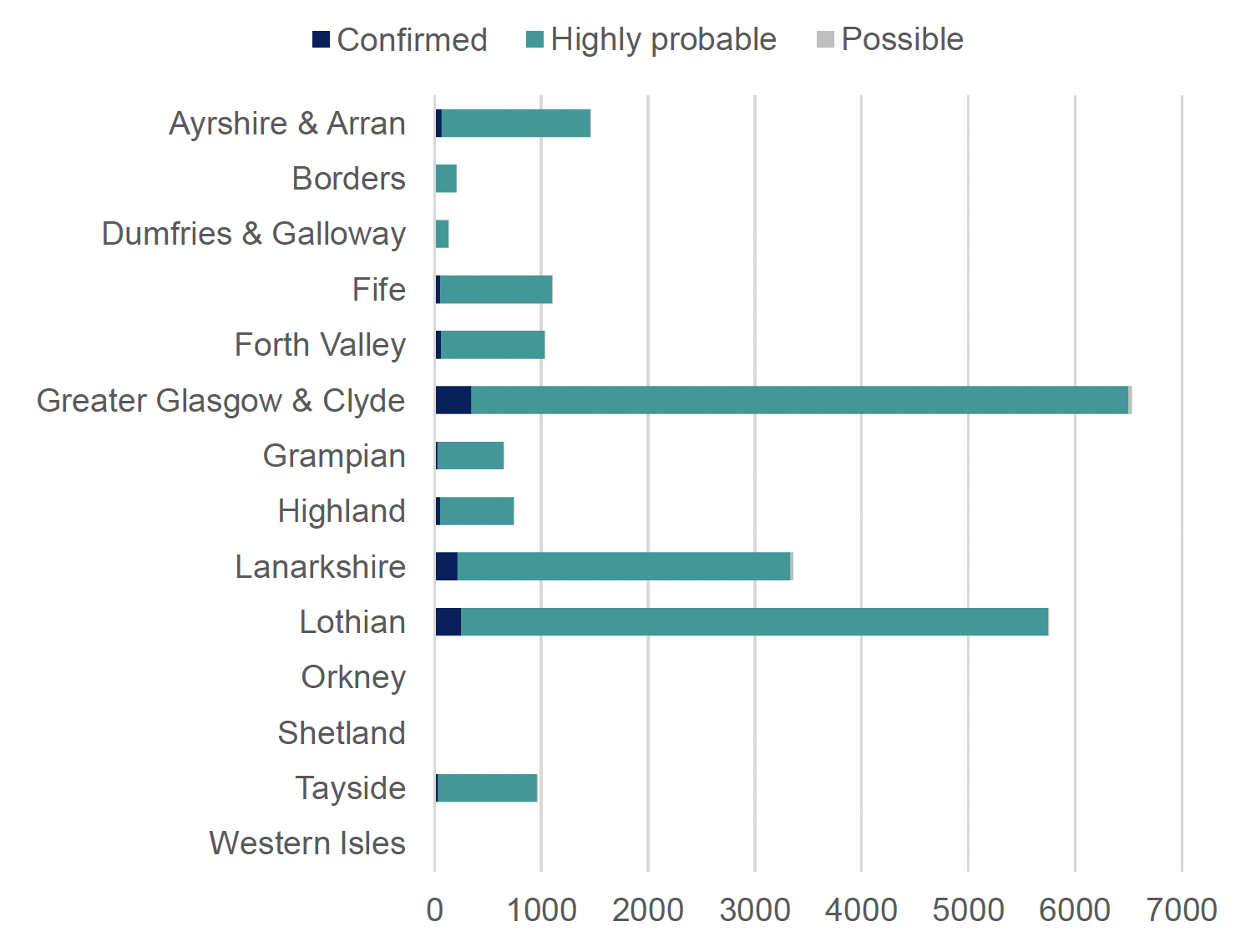
Testing Rates and Positivity
Tests per 1,000 population (seven day total) remained relatively stable throughout November with a slight decrease towards the end of the month. By 21 December tests per 1,000 people increased to 65. Test positivity rate in the last seven days (proportion of positive tests) has increased, and as of 21 December it was at 12.1% (Figure 7)[25].
There was a 67.1% increase in Lateral Flow Device tests that were carried out in Scotland from 12 December to 19 December 2021[26].
Scottish Contact Survey now asks whether people use Lateral Flow Device tests and if so how often. Approximately 70% of individuals have taken at least one lateral flow test within the last 7 days for the survey pertaining to the 9 – 15 December[27].
The youngest and oldest age groups (18-29 and 70+) have reported the lowest proportions of individuals who have taken one or more lateral flows, 64% and 56% respectively. In contrast, those aged between 30-69 report the highest proportion of individuals taking at least one lateral flow test within the last 7 days, with at least 73% taken at least one[28].
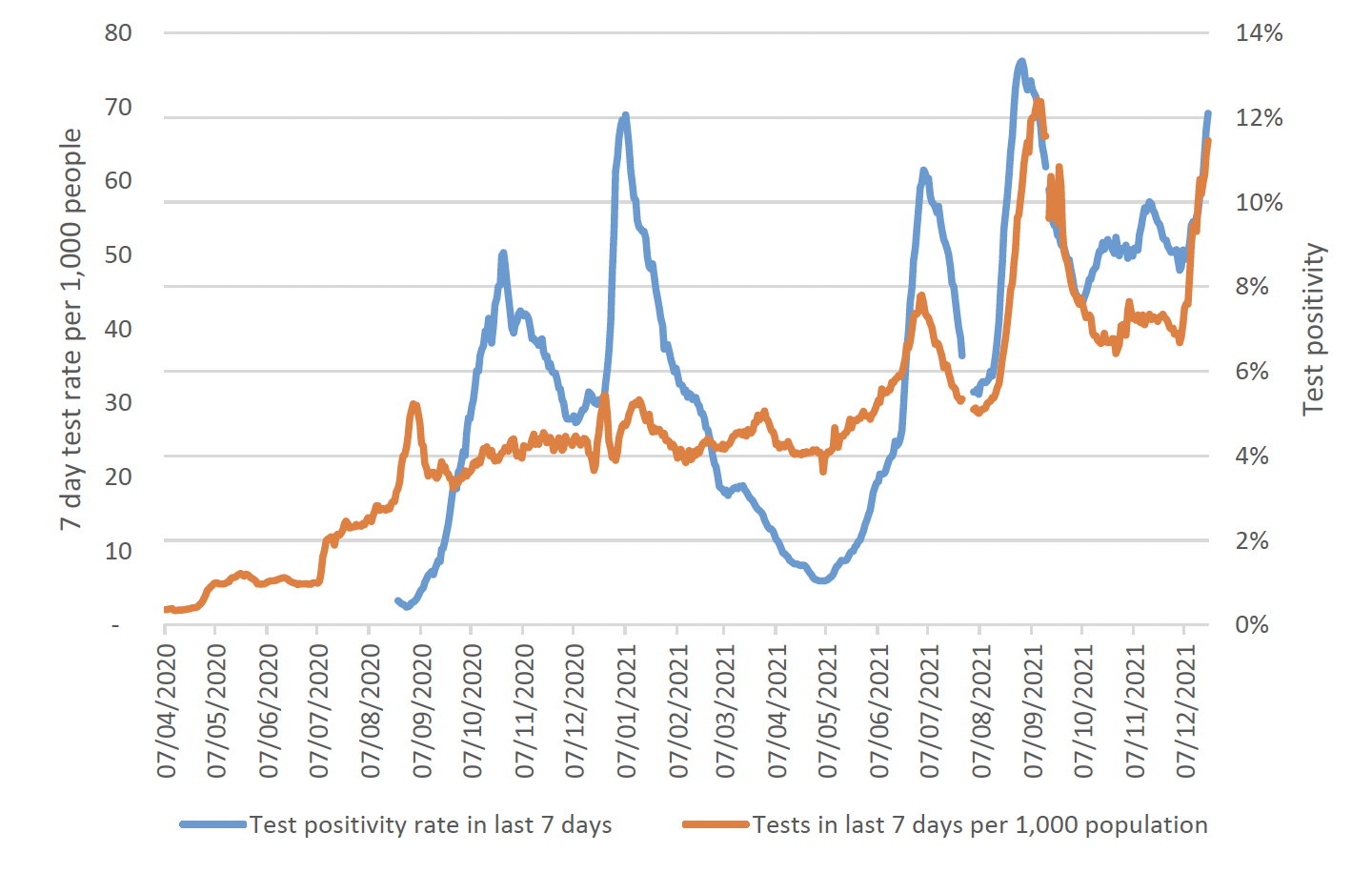
Wastewater Estimates
Measuring Covid-19 levels in wastewater is another way in which current infection levels can be estimated. In contrast to Covid-19 case records, virus shedding into wastewater is a biological process. This means that wastewater data is unaffected by factors that impact whether testing is done. Levels of SARS-CoV-2 in wastewater is monitored at sites around Scotland. Nationwide, wastewater Covid-19 RNA levels have shown an accelerated increase in the past week. The week ending on 20 December saw levels of around 129 million gene copies per person per day (Mgc/p/d), up from around 55 Mgc/p/d in the previous week, an increase of 135%. This matches the recent rise in cases caused by the rapid spread of Omicron variant.
Hospital and ICU Occupancy and Admissions
The latest data from PHS shows that admissions to hospitals have decreased in the last week, with 388 admissions to hospital for people with confirmed Covid-19 in the week to 18 December compared to 449 in the week to 11 December[30].
In the week to 22 December the number of people in hospital with confirmed Covid-19 has fluctuated and decreased by 1% overall since 15 December[31]. As of 22 December there were 536 patients in hospital with Covid-19 and 52 in ICU (short and long stay) (Figure 8)[32]. The number of Covid-19 patients in ICU (short and long stay) has fluctuated but has decreased by 4% overall since 15 December.
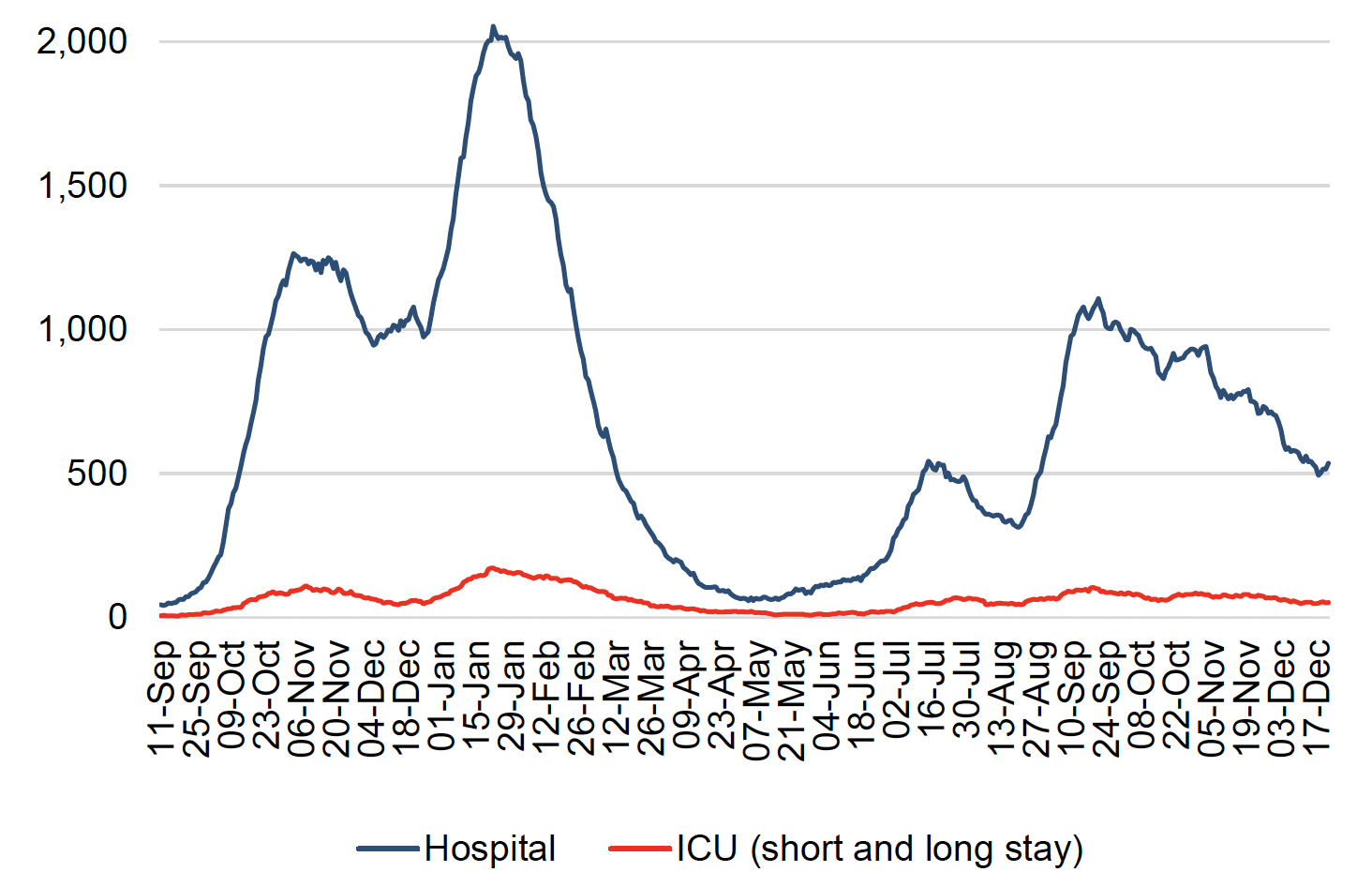
As the population is increasingly vaccinated, more of the patients in hospital will be fully or partially vaccinated. Therefore, it is important that we can differentiate between patients in hospital because of Covid-19 rather than with Covid-19. Public Health Scotland estimates that as at August 2021, 68% of Covid-19 related acute hospital admissions had a primary diagnosis of Covid-19. In March 2021 this figure stood at 75%, and then decreased to a low of 66% in April 2021. This increased to 75% in July, but saw a decrease in August[34].
Deaths
There were 68 deaths registered where Covid-19 was mentioned on the death certificate in the week to 19 December 2021. This is a decrease of 17 (-20%) in the number of deaths from the previous week, and 90% lower than the peak in April 2020 (663 deaths)[35].
In the same week, deaths involving coronavirus increased slightly among those aged 15-44, and decreased or remained stable in all other age groups compared to the week ending 12 December (Figure 9). National Records of Scotland publish a weekly detailed analysis on deaths involving Covid-19 in Scotland in their weekly report[36].
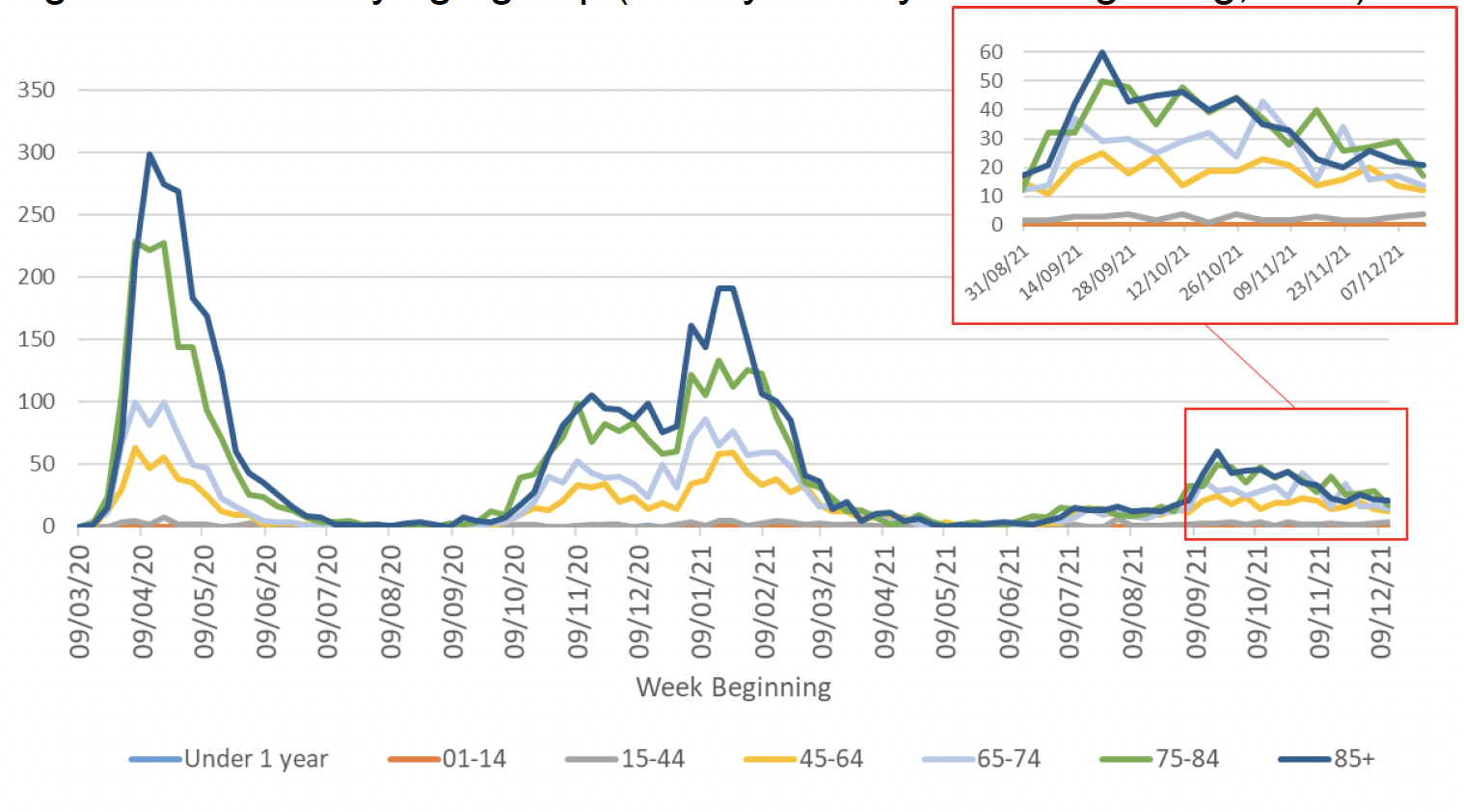
Vaccinations
The first vaccines were administered on Tuesday 8 December 2020 and by 22 December 2021 over 4.3 million people (91.3% of those aged 12+) had received their first dose and over 4 million people (83.6% of those aged 12+) had received their second dose[37]. There remains a low level of deaths amongst vaccinated individuals.
A booster dose or a third dose of the vaccine is now available in Scotland, in line with JCVI advice including all adults aged over 18 for whom it has been at least 12 weeks since their second dose. Over 2.7 million people (56.6% of those over 12 years of age) have received their dose 3 or booster vaccine by 22 December[38].
Booster vaccine uptake is at least 90% amongst males and females aged 60 or over, and around 80% for males and females aged 55-59. However, there is a difference between male and female vaccine uptake in those aged between 18 and 54 with females showing a higher uptake compared to males (Figure 10).
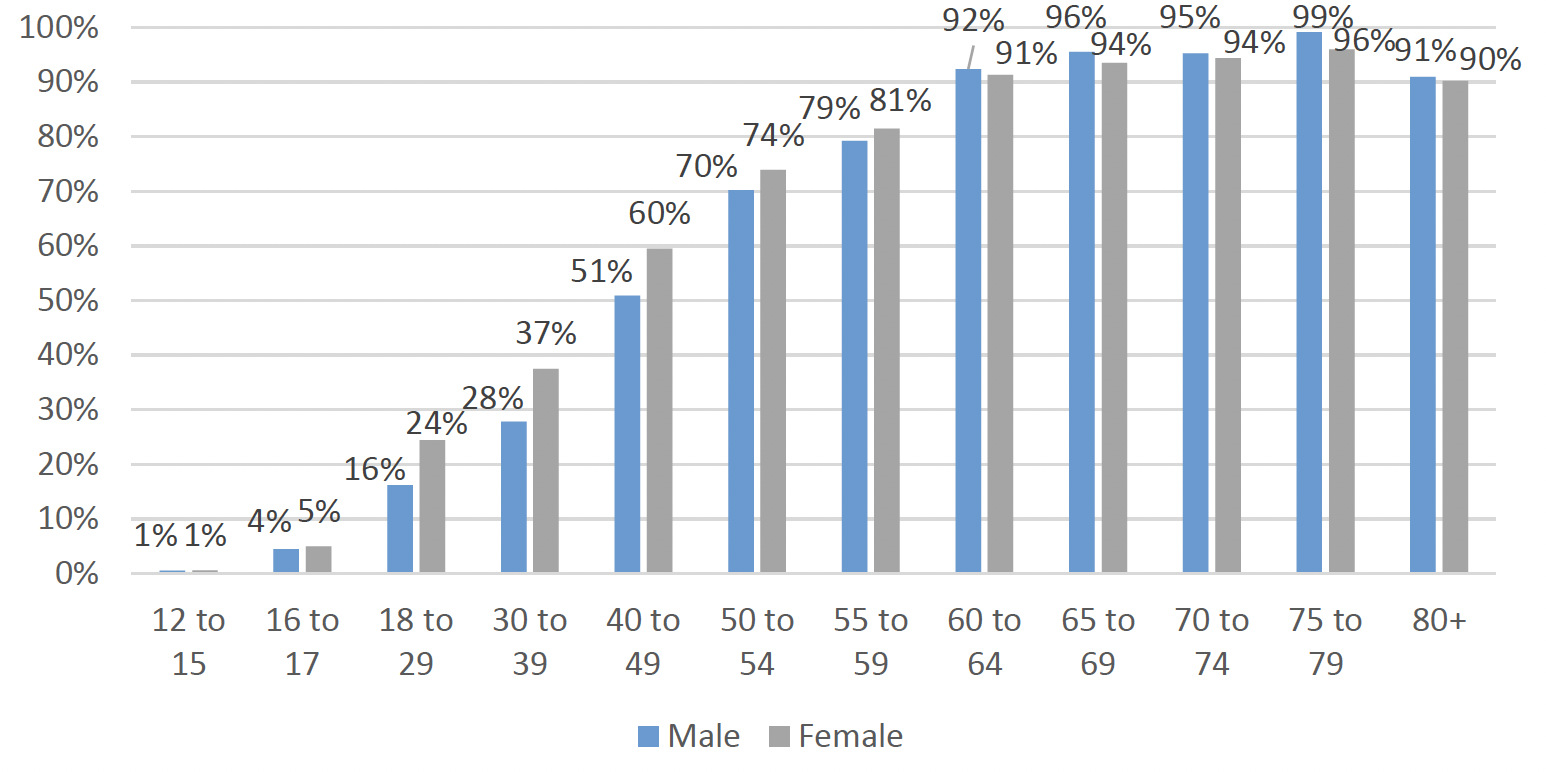
The effectiveness of vaccines
On 29 October 2021, the Vaccine Effectiveness Expert Panel (VEEP) published their updated consensus view on the effectiveness of different vaccines on infections, symptomatic disease, and severe disease against Delta variant as well as some initial evidence on vaccine waning effects[39]. The consensus view of vaccine effectiveness against symptomatic disease in fully vaccinated people is between 45-95%, depending on the vaccine and when it was administered however, protection against severe disease including hospitalisation and death remains high (over 80% after two doses of vaccine) over time. The latest UK Health Security Agency (UKHSA) data show an increase in vaccine effectiveness against symptomatic disease with Delta variant after the booster dose[40].
The UKHSA reported that Omicron is displaying a reduction in immune protection against infection, with first estimates of vaccine effectiveness for two doses of Pfizer-BioNTech and AstraZeneca vaccine significantly reduced. The third, booster dose of Pfizer-BioNTech vaccine restores protection against symptomatic disease to 70-75% in the early period after a booster dose. The data are insufficient to quantify the effect of booster on protection against severe disease[41].
PHS estimated in an analysis published on 25 November that 27,656 deaths in people 60 years and older have been directly averted as a result of Scotland's Covid-19 vaccination programme. This equates to an estimated 86% of deaths averted by vaccination in this age group[42].
Situation by local authority within Scotland
Please note that due to a technical issue cases by specimen date only cover until 18 December 2021.
Case rates have increased in Scotland over the past week, with 31 out of 32 local authorities seeing an increasing case rate over the week. West Lothian currently has the highest weekly case rate in Scotland reporting 1,045 weekly cases per 100,000 in the week to 18 December. Shetland has the lowest case rate in Scotland, reporting 310 weekly cases per 100,000 population in the week to 18 December[43] (Table 1 and Figure 11).
| Local authority | Total new cases in the week, per 100,000 population | Change since previous week |
|---|---|---|
| West Lothian | 1,045 | +389 |
| City of Edinburgh | 950 | +505 |
| Renfrewshire | 949 | +400 |
| East Renfrewshire | 900 | +259 |
| Midlothian | 899 | +384 |
| South Lanarkshire | 898 | +358 |
| West Dunbartonshire | 868 | +295 |
| East Dunbartonshire | 867 | +259 |
| Falkirk | 844 | +189 |
| North Ayrshire | 836 | +291 |
| North Lanarkshire | 809 | +288 |
| Glasgow City | 757 | +356 |
| East Lothian | 752 | +249 |
| East Ayrshire | 731 | +70 |
| Clackmannanshire | 721 | +287 |
| Stirling | 712 | +239 |
| South Ayrshire | 654 | +177 |
| Fife | 626 | +158 |
| Argyll and Bute | 592 | +242 |
| Moray | 564 | +114 |
| Inverclyde | 544 | +93 |
| Perth and Kinross | 514 | +115 |
| Dundee City | 475 | +210 |
| Aberdeenshire | 455 | +123 |
| Aberdeen City | 439 | +68 |
| Scottish Borders | 410 | +121 |
| Orkney Islands | 406 | +304 |
| Dumfries and Galloway | 384 | +16 |
| Angus | 374 | +82 |
| Highland | 338 | +40 |
| Na h-Eileanan Siar | 328 | -113 |
| Shetland Islands | 310 | +83 |
| Scotland | 705 | +248 |
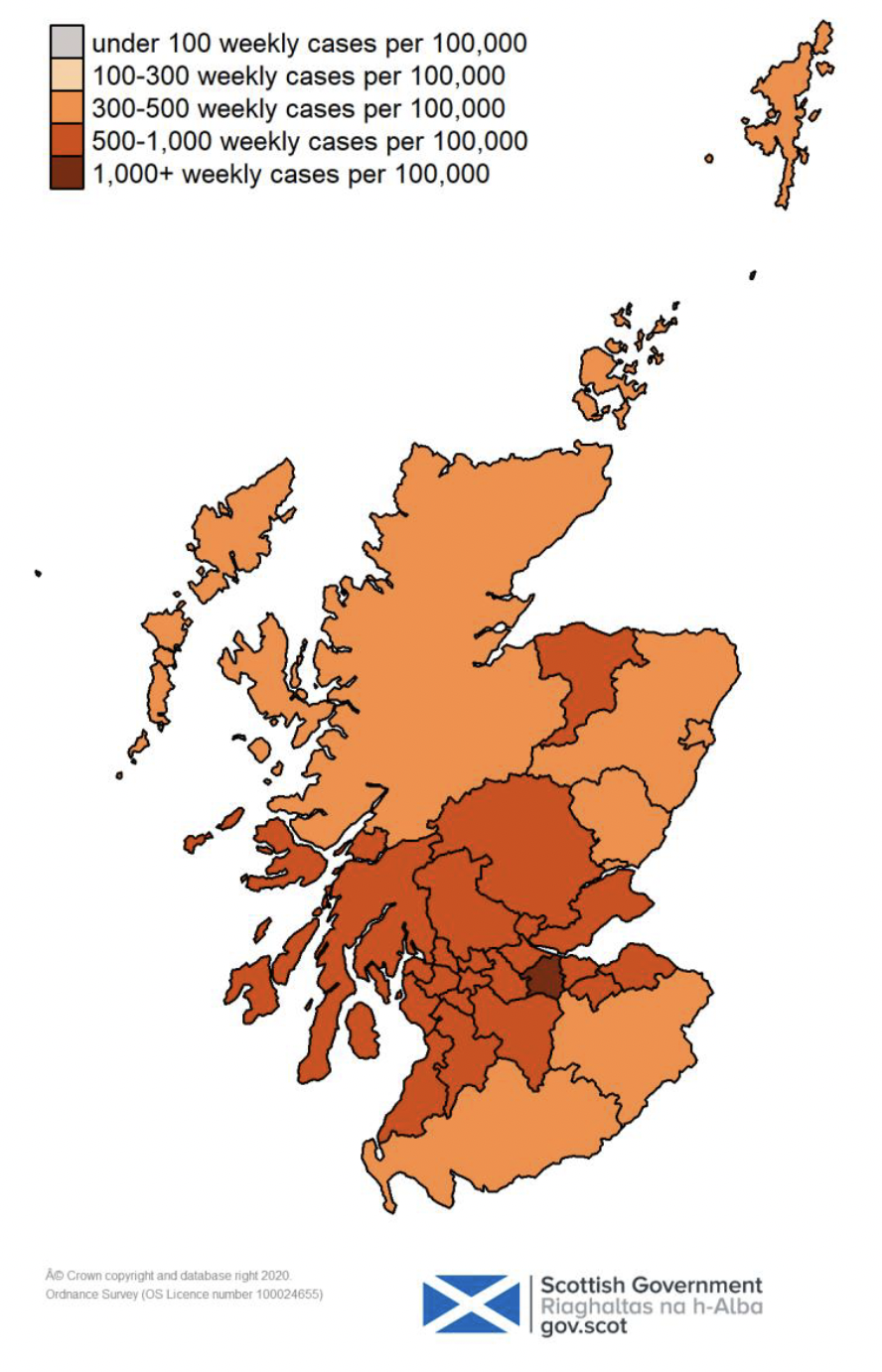
The most recent modelling predicts, based on data up to 20 December, that for the week commencing 2 January 2021, 29 out of the 32 local authorities are expected to exceed 50 cases per 100,000 population with at least 75% probability. The exceptions are Na h-Eileanan Siar, Orkney Islands and Shetland Islands. These 29 local authorities are also expected to exceed 100 cases per 100,000 with at least 75% probability.
23 local authorities are expected to exceed 500 cases per 100,000 with at least 75% probability[44]. These are Aberdeenshire, Argyll & Bute, Edinburgh, Clackmannanshire, Dundee, East Ayrshire, East Dunbartonshire, East Lothian, East Renfrewshire, Falkirk, Fife, Glasgow, Midlothian, Moray, North Ayrshire, North Lanarkshire, Perth & Kinross, Renfrewshire, South Ayrshire, South Lanarkshire, Stirling, West Dunbartonshire and West Lothian.
We are not able to provide data at higher threshold levels but it is likely that some local authorities may exceed 750 or 1000 cases per 100,000
How Scotland compares with the rest of the UK
Average daily cases in Scotland (955 per 1 million population) in the week to 21 December were below the other UK nations:
- England (1,435 per 1 million)
- Wales (1,051 per 1 million)
- Northern Ireland (1,166 per 1 million)[45].
Average daily deaths in Scotland (1 per 1 million population) in the week to 21 December were similar to Wales (1 per 1 million population) and below England and Northern Ireland (2 per 1 million each)[46].
There were 8,008 confirmed Covid-19 patients in hospital in the UK on 21 December 2021, with 6,902 of them reported in England, 515 in Scotland, 330 in Wales and 261 in Northern Ireland[47]. This translates to 12 patients per 100,000 population for England, 9 patients per 100,000 in Scotland, 11 per 100,000 for Wales and 16 per 100,000 for Northern Ireland (based on 7 day averages for all 4 nations). Please note that data about Covid-19 patients in hospitals are collected differently by each nation and therefore might not be directly comparable.
The ONS Covid-19 Infection Survey estimates that in the week 10 to 16 December 2021, the estimated percentage of the population living in private residential households testing positive for Covid-19 in Scotland was 1.45% (95% credible interval: 1.20% to 1.72%). The percentage of people testing positive for Covid-19 in the private residential population increased in the most recent week. In the week 10 to 16 December 2021, estimates for the other nations of the UK are as follows:
- In England, the trend in the percentage of people testing positive in private residential households increased in the most recent week: 2.21% (95% credible interval: 2.10% to 2.32%).
- In Wales, the trend in the percentage of people testing positive in private residential households was uncertain in the most recent week: 1.79% (95% credible interval: 1.46% to 2.15%).
- In Northern Ireland, the trend in the percentage of people testing positive in private residential households was uncertain in the most recent week: 2.06% (95% credible interval: 1.59% to 2.60%)[48].
The ONS Covid-19 Infection Survey estimated that in the week beginning 29 November 2021, 95.0% (95% CI: 94.0% to 95.9%) of the adult population living in private residential households in Scotland would have tested positive for antibodies against SARS-CoV-2, as a result of having the infection in the past or being vaccinated. This compares to
- 95.0% in England (95% CI: 94.2% to 95.7%),
- 93.6% in Wales (95% CI: 92.3% to 94.8%),
- 95.0% in Northern Ireland (95% CI: 94.0% to 95.9%)[49].
An estimated 1.9% of the population living in private residential households in the UK were experiencing self-reported long Covid symptoms (symptoms persisting for more than four weeks after the first suspected coronavirus (Covid-19) infection that were not explained by something else) in the 4 weeks ending 31 October 2021. In Scotland, 99,000 people (1.87% of the respective population) living in private households self-reported long Covid symptoms for this period. This compares to 1.88% in England, 1.80% in Wales and 1.52% in Northern Ireland[50].
Looking ahead
Scottish Contact Survey
Changes in patterns of mixing and adherence to restrictions will impact on future case numbers. The Scottish Contact Survey measures times and settings that people mix where they could potentially spread Covid-19. Average contacts from the most recent Panel A cohort of the Scottish Contact Survey (week ending 15 December) indicate an average of 5.8 contacts.
Mean contacts have increased within the work and other setting (contacts outside home, school and work) rising by 15% and 57% respectively. Contacts within the home have remained at a similar level over the same period.
All age groups, with the exception of those aged 60-69, have increased their overall mean contacts. The biggest increase is within the 30-39 age group, more than doubling compared to two weeks prior. This is largely driven by contacts in the workplace.
Self-reported compliance with the current regulations and guidance has decreased since January but remains at a high level. On 14-15 December, 68% of people reported 'complete' or 'almost complete' compliance[51].
Modelling the Epidemic
The Scottish Government assesses the impact of Covid-19 on the NHS in the next few weeks, in this research findings we focus on estimating the number of infections. The latest Modelling the Epidemic report shows estimated number of infections, including projections over the three weeks to 2 January, broken down by possible Omicron infections, Delta infections, and combined infections. Due to uncertainty surrounding the Omicron variant and its increasing prevalence across the UK, it has not been possible to produce consensus medium-term projections for hospital admissions and deaths this week. We hope to be able to provide hospitalisation and ICU in future weeks which account for the Omicron variant as well as Delta.
Next steps
The Scottish Government continues to work closely with Public Health Scotland and modelling groups to monitor what is happening across Scotland.
Each week this report will provide an overview of the current Covid-19 situation in Scotland. This will include real time data on case rates, hospitalisations and deaths and how Scotland's figures compare to those from the rest of the UK.
Modelling can tell us where the epidemic is likely to be heading. Local data and data by age group can highlight where problems arise, which can help in addressing some of these issues. In the coming weeks the roll out of the vaccine will continue to be monitored along with the impact of this on case rates and deaths among different age cohorts. Investigations are ongoing by NERVTAG, SPI-M, SAGE, UKHSA, Public Health England and Public Health Scotland regarding the impact of new variants and of vaccination; this will be reflected here as work is undertaken.
Contact
There is a problem
Thanks for your feedback